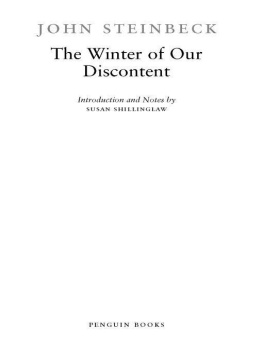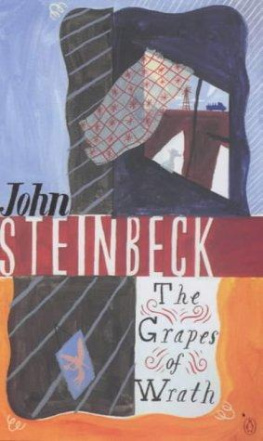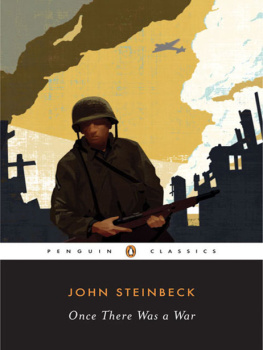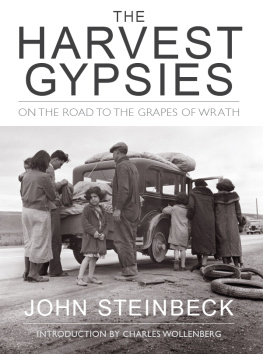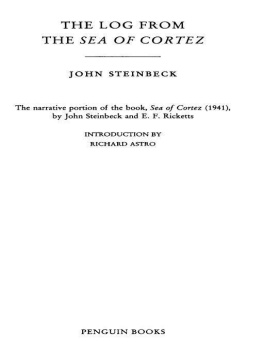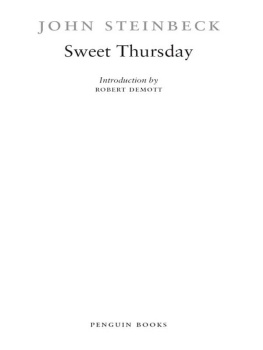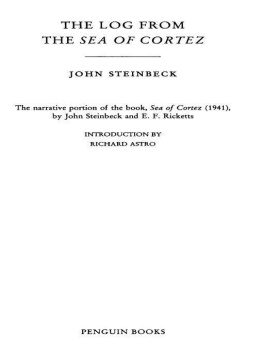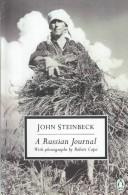Table of Contents
PENGUIN
CLASSICS
THE WINTER OF OUR DISCONTENT
JOHN STEINBECK (1902-68) was born in Salinas, California, in 1902 and grew up in a fertile agricultural valley about twenty-five miles from the Pacific Coastand both valley and coast would serve as settings for some of his best fiction. In 1919 he went to Stanford University, where he intermittently enrolled in literature and writing courses until he left in 1925 without a degree. During the next five years, he supported himself as a laborer and journalist in New York City and then as a caretaker for a Lake Tahoe estate, all the time working on his first novel, Cup of Gold (1929). After marriage and a move to Pacific Grove, he published two California fictions, The Pastures of Heaven (1932) and To a God Unknown (1933), and worked on short stories later collected in The Long Valley (1938). Popular success and financial security came only with Tortilla Flat (1935), stories about Montereys paisanos . A ceaseless experimenter throughout his career, Steinbeck changed courses regularly. The powerful novels of the late 1930s focused on the California laboring class: In Dubious Battle (1936), Of Mice and Men (1937), and the book considered by many his finest, The Grapes of Wrath (1939). Early in the 1940s, Steinbeck became a filmmaker with The Forgotten Village (1941) and a serious student of marine biology with Sea of Cortez (1941). He devoted his services to the war, writing Bombs Away (1942) and the controversial play-novelette The Moon Is Down (1942). Cannery Row (1945); The Wayward Bus (1947); The Pearl (1947); A Russian Journal (1948); another experimental drama, Burning Bright (1950); and The Log from the Sea of Cortez (1951) preceded publication of the monumental East of Eden (1952), an ambitious saga of the Salinas Valley and his own familys history. The last decades of his life were spent in New York City and Sag Harbor with his third wife, with whom he traveled widely. Later books include Sweet Thursday (1954), The Short Reign of Pippin IV: A Fabrication (1957), Once There Was a War (1958), The Winter of Our Discontent (1961), Travels with Charley in Search of America (1962), America and Americans (1966), and the posthumously published Journal of a Novel: The East of Eden Letters (1969), Viva Zapata! (1975), The Acts of King Arthur and His Noble Knights (1976), and Working Days: The Journals of The Grapes of Wrath (1989). He died in 1968, having won a Nobel Prize in 1962.
SUSAN SHILLINGLAW is a professor of English at San Jose State University and scholar-in-residence at the National Steinbeck Center in Salinas. She has published several articles on Steinbeck and coedited Steinbeck and the Environment, John Steinbeck: The Contemporary Reviews, and America and Americans and Selected Nonfiction. Her most recent book is A Journey into Steinbecks California. She is completing a biography of Steinbecks first wife, Carol Henning Steinbeck.

PENGUIN BOOKS
Published by the Penguin Group
Penguin Group (USA) Inc., 375 Hudson Street, New York, New York 10014, U.S.A.
Penguin Group (Canada), 90 Eglinton Avenue East, Suite 700, Toronto,
Ontario, Canada M4P 2Y3 (a division of Pearson Penguin Canada Inc.)
Penguin Books Ltd., 80 Strand, London WC2R 0RL, England
Penguin Ireland, 25 St. Stephens Green, Dublin 2,
Ireland (a division of Penguin Books Ltd)
Penguin Group (Australia), 250 Camberwell Road, Camberwell,
Victoria 3124, Australia (a division of Pearson Australia Group Pty Ltd)
Penguin Books India Pvt Ltd, 11 Community Centre,
Panchsheel Park, New Delhi-110 017, India
Penguin Group (NZ), 67 Apollo Drive, Rosedale, North Shore 0632,
New Zealand (a division of Pearson New Zealand Ltd)
Penguin Books (South Africa) (Pty) Ltd, 24 Sturdee Avenue,
Rosebank, Johannesburg 2196, South Africa
Penguin Books Ltd, Registered Offices:
80 Strand, London WC2R 0RL, England
First published in the United States of America by The Viking Press 1961
Published in Penguin Books 1982
This edition with an introduction and notes by Susan Shillinglaw published 2008
Copyright John Steinbeck, 1961
Copyright renewed Elaine Steinbeck, Thom Steinbeck, and John Steinbeck IV, 1989
Introduction and notes copyright Susan Shillinglaw, 2008
All rights reserved
A serial version of this work appeared in McCalls .
LIBRARY OF CONGRESS CATALOGING-IN-PUBLICATION DATA
Steinbeck, John, 1902-1968.
The winter of our discontent / John Steinbeck; introduction and notes by Susan Shillinglaw.
p. cm.(Penguin classics.)
Includes bibliographical references.
eISBN : 978-1-436-25781-7
1. Grocery tradeEmployeesFiction. 2. Conduct of lifeFiction. 3. Domestic fiction. I. Shillinglaw,
Susan. II. Title.
PS3537.T3234W5 2008
813.52dc22 2008018574
Printed in the United States of America
Except in the United States of America, this book is sold subject to the condition that it shall not, by way of trade or otherwise, be lent, resold, hired out, or otherwise circulated without the publishers prior consent in any form of binding or cover other than that in which it is published and without a similar condition including this condition being imposed on the subsequent purchaser.
The scanning, uploading, and distributing of this book via the Internet or via any other means without the permission of the publisher is illegal and punishable by law. Please purchase only authorized electronic editions, and do not participate in or encourage electronic piracy of copyrighted materials. Your support of the authors rights is appreciated.
http://us.penguingroup.com
Introduction
The Winter of Our Discontent is John Steinbecks last novel, the book that occasioned his 1962 Nobel Prize for Literature. On the eve of the ceremony, the New York Times published an editorial by Arthur Mizener questioning the wisdom of the Swedish Academys decision: Does a Moral Vision of the Thirties Deserve a Nobel Prize? The article seared Steinbecks soul, no doubt, and placed once again before his American readers the enigma of his reputation. How to define this most American of writers, the engaged artist of 1930s California? And how to describe this last novel, certainly not a howl of social protest in the vein of his 1939 classic, The Grapes of Wrath , but neither the twilight reflections of an aging writer. For many readers The Winter of Our Discontent is a dark morality tale about the fall of a blue-blooded American hero, Ethan Allen Hawley, who succumbs to the temptations of wealth, power, and prestige. But this final novel defies categories. If its a parable of corruption and redemption, as Steinbeck suggests in his epigraph, its also a lesson in Darwinian survival. The novel insists on a symbolic and highly ironic frameworkthe first half takes place on Easter weekend in April 1960 and the second on the Fourth of July weekend that same year. Yet the book is also realistic, set in Steinbecks own Sag Harbor, New YorkNew Baytown in the noveland influenced by the moral quagmires of contemporary America. And while the work tips its hat to Steinbecks love of the Arthurian saga, with Ethan a latter-day Lancelot, its also true that Ethans voice seems almost postmodern, speaking a language that is highly wrought, artificial, self-reflective. The Winterof Our Discontent is, seemingly, a patchwork of intentions, all meant to shake a readers complacency.

